BMP3004: World of Work - Functional Areas, Skills and Analysis
VerifiedAdded on 2022/11/23
|9
|2518
|217
Report
AI Summary
This report, prepared for a BSc (Hons) Business Management course, delves into the functional areas of a business, providing definitions and descriptions of each. It covers marketing, human resource management, customer service, finance, research and development, and sales. The report highlights the types of skills required for employees to work effectively in these areas, including communication, teamwork, time management, problem-solving, integrity, motivation, critical thinking, flexibility, resilience, dedication, and empathy. The introduction emphasizes the importance of effective management planning and strategies for business operations, with a focus on the small-sized corporation Morningstar care. The conclusion reinforces the significance of sound management decisions for organizational success and profit maximization, referencing various academic sources.
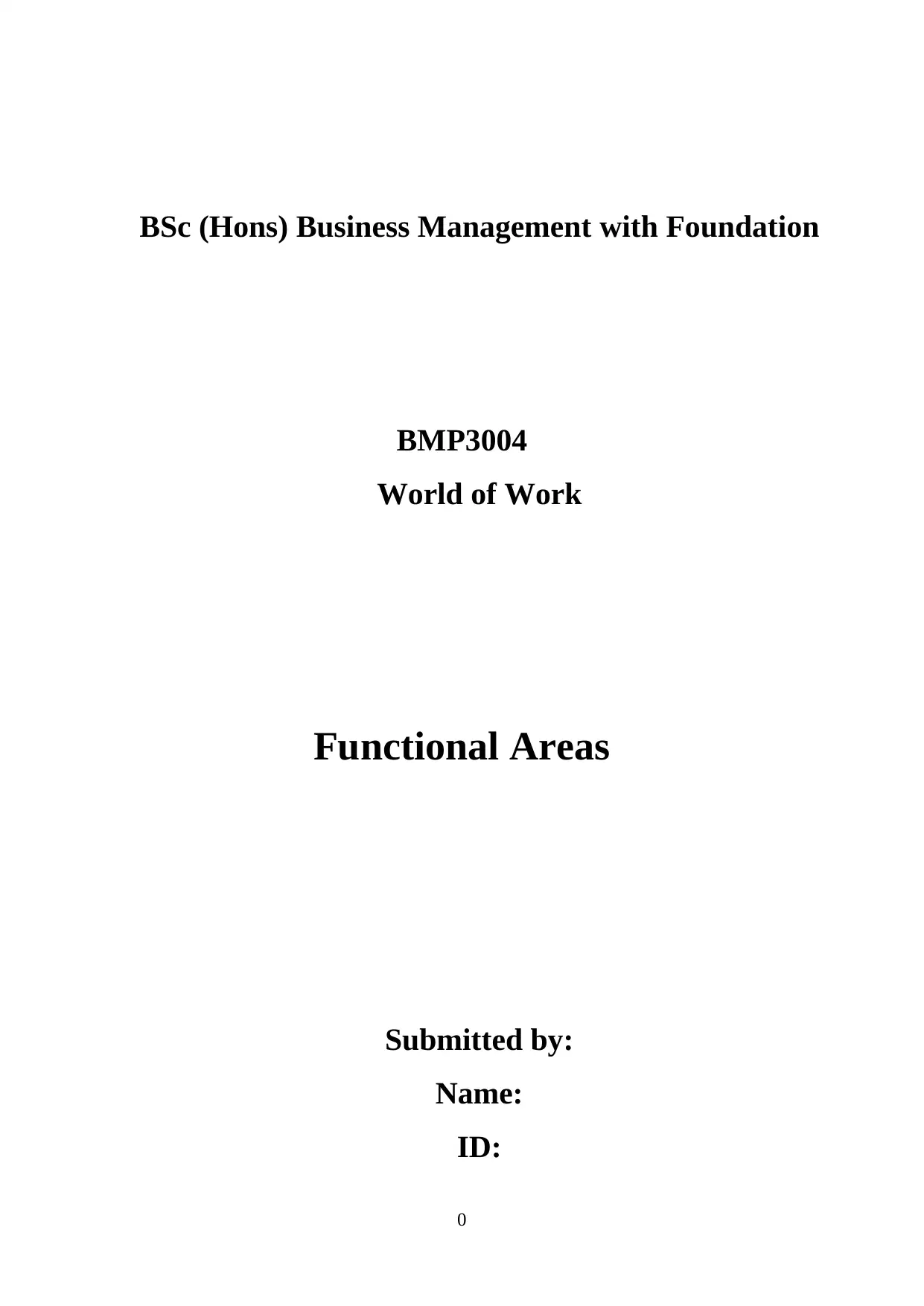
BSc (Hons) Business Management with Foundation
BMP3004
World of Work
Functional Areas
Submitted by:
Name:
ID:
0
BMP3004
World of Work
Functional Areas
Submitted by:
Name:
ID:
0
Paraphrase This Document
Need a fresh take? Get an instant paraphrase of this document with our AI Paraphraser
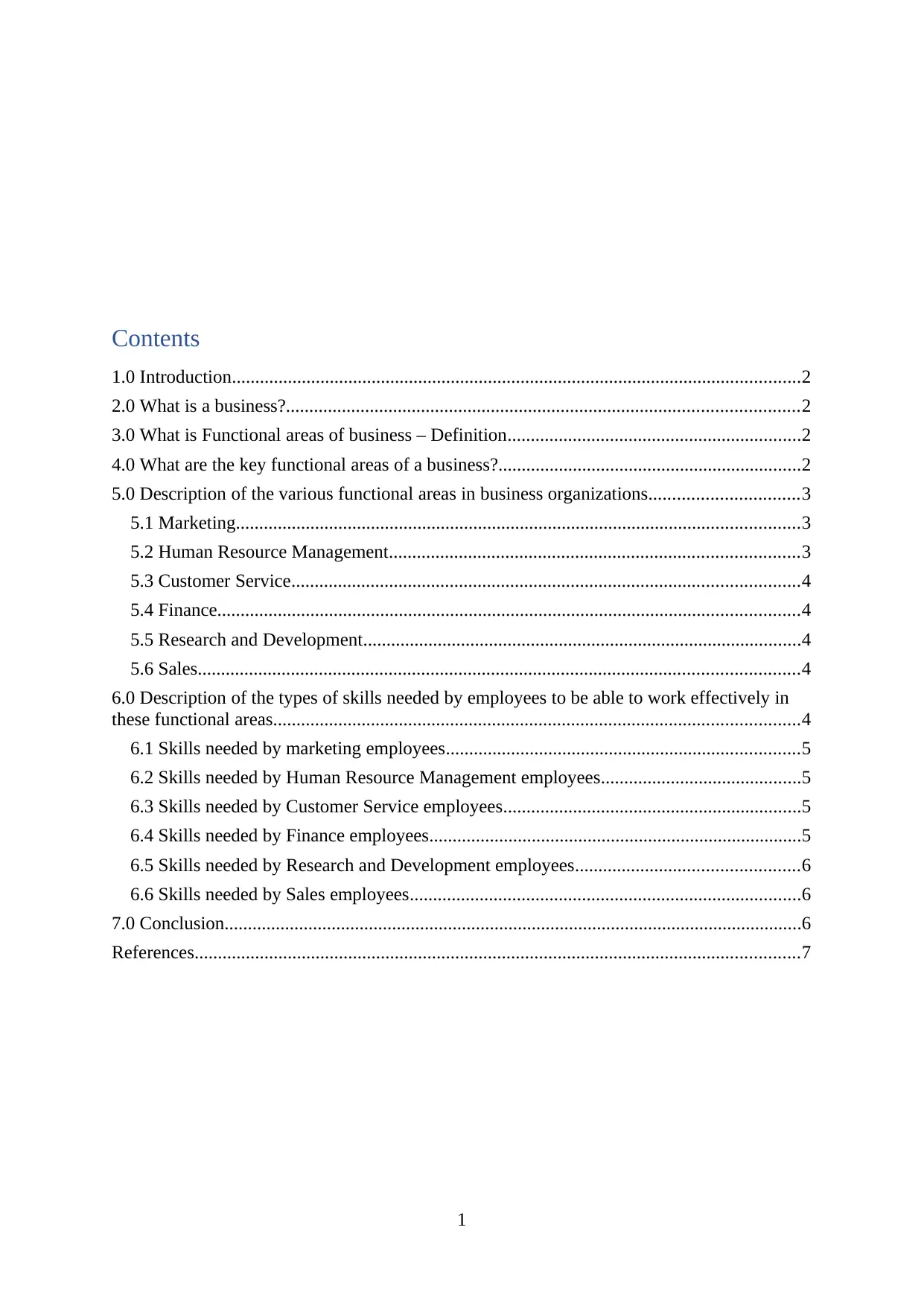
Contents
1.0 Introduction..........................................................................................................................2
2.0 What is a business?..............................................................................................................2
3.0 What is Functional areas of business – Definition...............................................................2
4.0 What are the key functional areas of a business?.................................................................2
5.0 Description of the various functional areas in business organizations................................3
5.1 Marketing.........................................................................................................................3
5.2 Human Resource Management........................................................................................3
5.3 Customer Service.............................................................................................................4
5.4 Finance.............................................................................................................................4
5.5 Research and Development..............................................................................................4
5.6 Sales.................................................................................................................................4
6.0 Description of the types of skills needed by employees to be able to work effectively in
these functional areas.................................................................................................................4
6.1 Skills needed by marketing employees............................................................................5
6.2 Skills needed by Human Resource Management employees...........................................5
6.3 Skills needed by Customer Service employees................................................................5
6.4 Skills needed by Finance employees................................................................................5
6.5 Skills needed by Research and Development employees................................................6
6.6 Skills needed by Sales employees....................................................................................6
7.0 Conclusion............................................................................................................................6
References..................................................................................................................................7
1
1.0 Introduction..........................................................................................................................2
2.0 What is a business?..............................................................................................................2
3.0 What is Functional areas of business – Definition...............................................................2
4.0 What are the key functional areas of a business?.................................................................2
5.0 Description of the various functional areas in business organizations................................3
5.1 Marketing.........................................................................................................................3
5.2 Human Resource Management........................................................................................3
5.3 Customer Service.............................................................................................................4
5.4 Finance.............................................................................................................................4
5.5 Research and Development..............................................................................................4
5.6 Sales.................................................................................................................................4
6.0 Description of the types of skills needed by employees to be able to work effectively in
these functional areas.................................................................................................................4
6.1 Skills needed by marketing employees............................................................................5
6.2 Skills needed by Human Resource Management employees...........................................5
6.3 Skills needed by Customer Service employees................................................................5
6.4 Skills needed by Finance employees................................................................................5
6.5 Skills needed by Research and Development employees................................................6
6.6 Skills needed by Sales employees....................................................................................6
7.0 Conclusion............................................................................................................................6
References..................................................................................................................................7
1
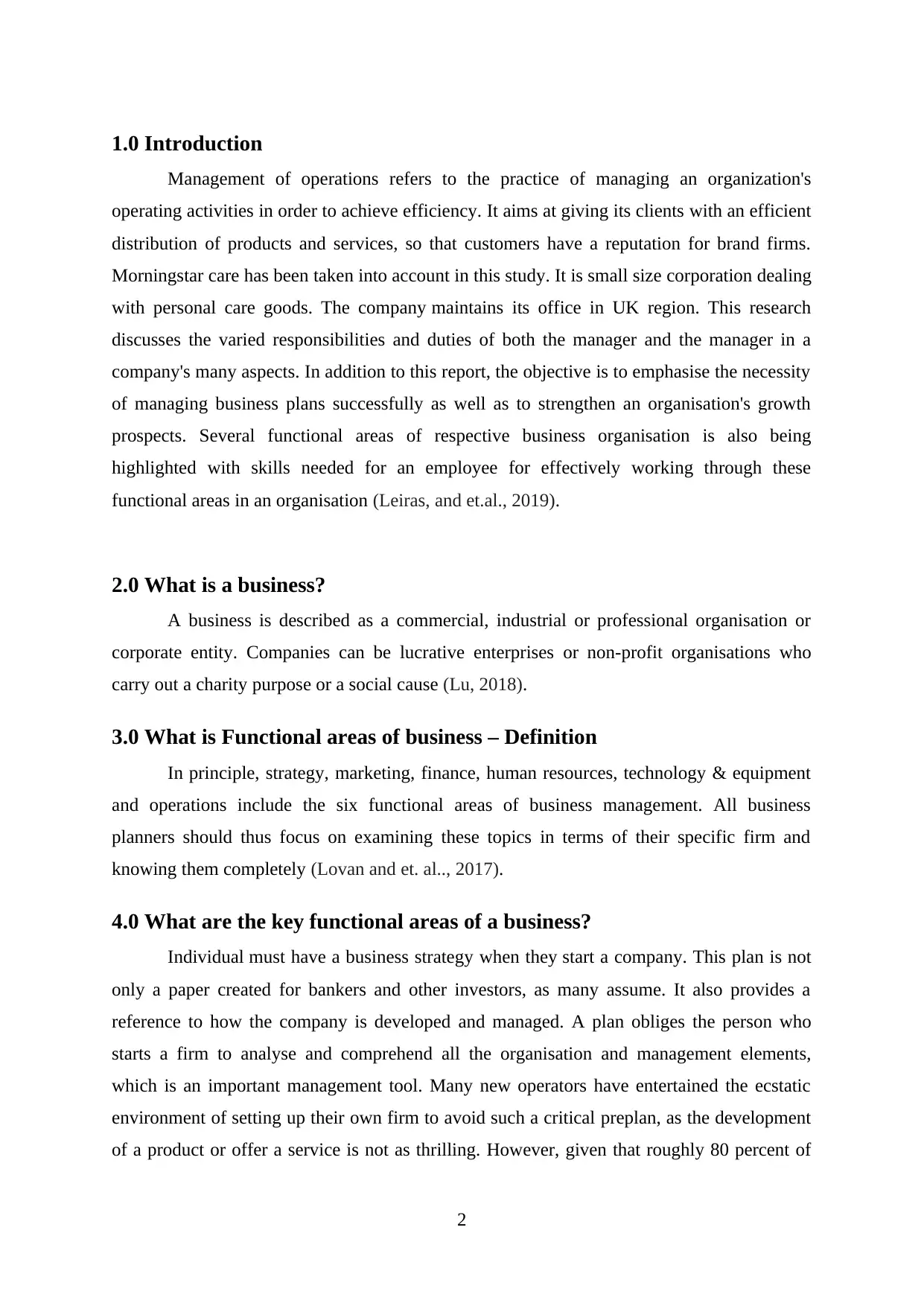
1.0 Introduction
Management of operations refers to the practice of managing an organization's
operating activities in order to achieve efficiency. It aims at giving its clients with an efficient
distribution of products and services, so that customers have a reputation for brand firms.
Morningstar care has been taken into account in this study. It is small size corporation dealing
with personal care goods. The company maintains its office in UK region. This research
discusses the varied responsibilities and duties of both the manager and the manager in a
company's many aspects. In addition to this report, the objective is to emphasise the necessity
of managing business plans successfully as well as to strengthen an organisation's growth
prospects. Several functional areas of respective business organisation is also being
highlighted with skills needed for an employee for effectively working through these
functional areas in an organisation (Leiras, and et.al., 2019).
2.0 What is a business?
A business is described as a commercial, industrial or professional organisation or
corporate entity. Companies can be lucrative enterprises or non-profit organisations who
carry out a charity purpose or a social cause (Lu, 2018).
3.0 What is Functional areas of business – Definition
In principle, strategy, marketing, finance, human resources, technology & equipment
and operations include the six functional areas of business management. All business
planners should thus focus on examining these topics in terms of their specific firm and
knowing them completely (Lovan and et. al.., 2017).
4.0 What are the key functional areas of a business?
Individual must have a business strategy when they start a company. This plan is not
only a paper created for bankers and other investors, as many assume. It also provides a
reference to how the company is developed and managed. A plan obliges the person who
starts a firm to analyse and comprehend all the organisation and management elements,
which is an important management tool. Many new operators have entertained the ecstatic
environment of setting up their own firm to avoid such a critical preplan, as the development
of a product or offer a service is not as thrilling. However, given that roughly 80 percent of
2
Management of operations refers to the practice of managing an organization's
operating activities in order to achieve efficiency. It aims at giving its clients with an efficient
distribution of products and services, so that customers have a reputation for brand firms.
Morningstar care has been taken into account in this study. It is small size corporation dealing
with personal care goods. The company maintains its office in UK region. This research
discusses the varied responsibilities and duties of both the manager and the manager in a
company's many aspects. In addition to this report, the objective is to emphasise the necessity
of managing business plans successfully as well as to strengthen an organisation's growth
prospects. Several functional areas of respective business organisation is also being
highlighted with skills needed for an employee for effectively working through these
functional areas in an organisation (Leiras, and et.al., 2019).
2.0 What is a business?
A business is described as a commercial, industrial or professional organisation or
corporate entity. Companies can be lucrative enterprises or non-profit organisations who
carry out a charity purpose or a social cause (Lu, 2018).
3.0 What is Functional areas of business – Definition
In principle, strategy, marketing, finance, human resources, technology & equipment
and operations include the six functional areas of business management. All business
planners should thus focus on examining these topics in terms of their specific firm and
knowing them completely (Lovan and et. al.., 2017).
4.0 What are the key functional areas of a business?
Individual must have a business strategy when they start a company. This plan is not
only a paper created for bankers and other investors, as many assume. It also provides a
reference to how the company is developed and managed. A plan obliges the person who
starts a firm to analyse and comprehend all the organisation and management elements,
which is an important management tool. Many new operators have entertained the ecstatic
environment of setting up their own firm to avoid such a critical preplan, as the development
of a product or offer a service is not as thrilling. However, given that roughly 80 percent of
2
⊘ This is a preview!⊘
Do you want full access?
Subscribe today to unlock all pages.

Trusted by 1+ million students worldwide
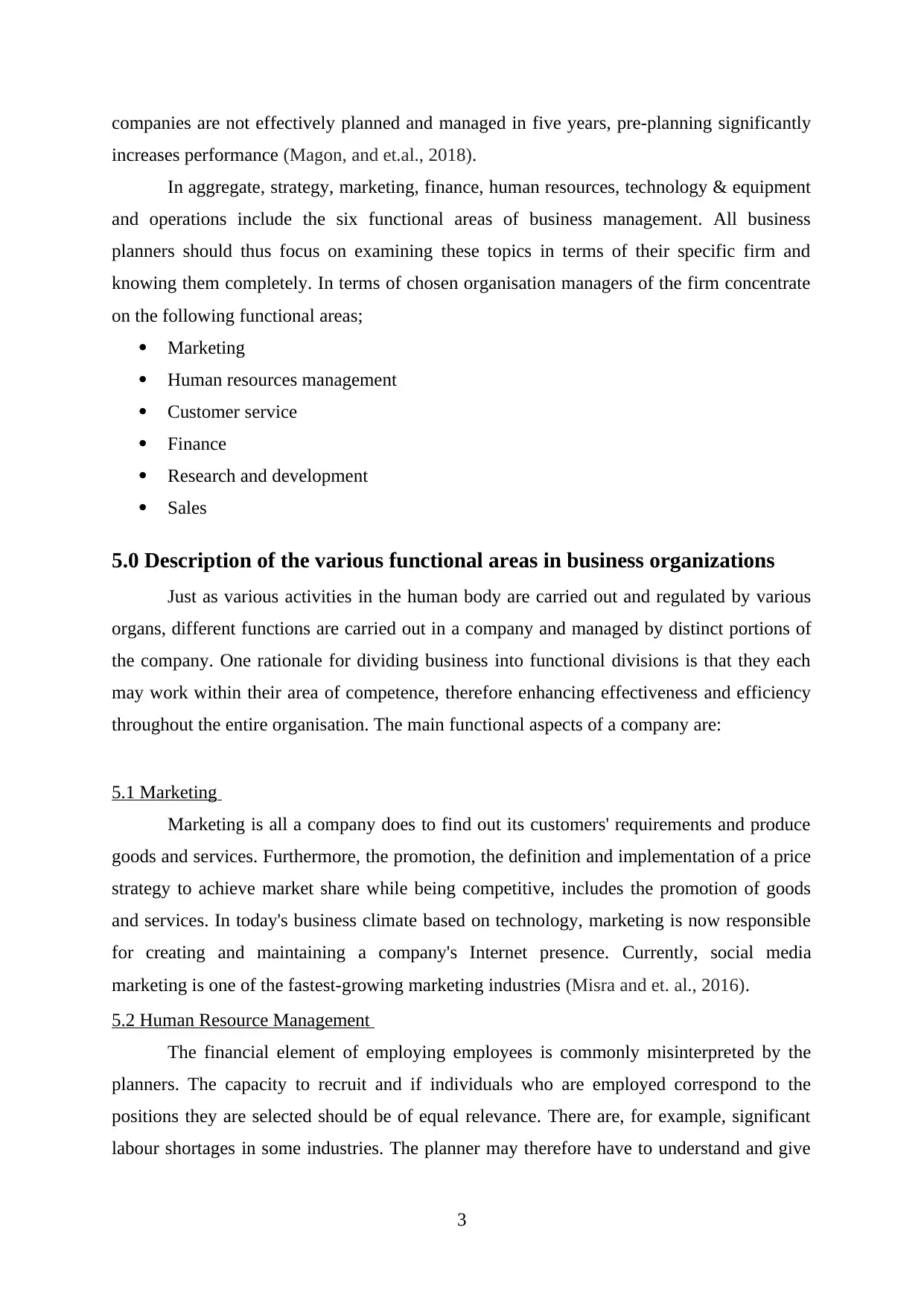
companies are not effectively planned and managed in five years, pre-planning significantly
increases performance (Magon, and et.al., 2018).
In aggregate, strategy, marketing, finance, human resources, technology & equipment
and operations include the six functional areas of business management. All business
planners should thus focus on examining these topics in terms of their specific firm and
knowing them completely. In terms of chosen organisation managers of the firm concentrate
on the following functional areas;
Marketing
Human resources management
Customer service
Finance
Research and development
Sales
5.0 Description of the various functional areas in business organizations
Just as various activities in the human body are carried out and regulated by various
organs, different functions are carried out in a company and managed by distinct portions of
the company. One rationale for dividing business into functional divisions is that they each
may work within their area of competence, therefore enhancing effectiveness and efficiency
throughout the entire organisation. The main functional aspects of a company are:
5.1 Marketing
Marketing is all a company does to find out its customers' requirements and produce
goods and services. Furthermore, the promotion, the definition and implementation of a price
strategy to achieve market share while being competitive, includes the promotion of goods
and services. In today's business climate based on technology, marketing is now responsible
for creating and maintaining a company's Internet presence. Currently, social media
marketing is one of the fastest-growing marketing industries (Misra and et. al., 2016).
5.2 Human Resource Management
The financial element of employing employees is commonly misinterpreted by the
planners. The capacity to recruit and if individuals who are employed correspond to the
positions they are selected should be of equal relevance. There are, for example, significant
labour shortages in some industries. The planner may therefore have to understand and give
3
increases performance (Magon, and et.al., 2018).
In aggregate, strategy, marketing, finance, human resources, technology & equipment
and operations include the six functional areas of business management. All business
planners should thus focus on examining these topics in terms of their specific firm and
knowing them completely. In terms of chosen organisation managers of the firm concentrate
on the following functional areas;
Marketing
Human resources management
Customer service
Finance
Research and development
Sales
5.0 Description of the various functional areas in business organizations
Just as various activities in the human body are carried out and regulated by various
organs, different functions are carried out in a company and managed by distinct portions of
the company. One rationale for dividing business into functional divisions is that they each
may work within their area of competence, therefore enhancing effectiveness and efficiency
throughout the entire organisation. The main functional aspects of a company are:
5.1 Marketing
Marketing is all a company does to find out its customers' requirements and produce
goods and services. Furthermore, the promotion, the definition and implementation of a price
strategy to achieve market share while being competitive, includes the promotion of goods
and services. In today's business climate based on technology, marketing is now responsible
for creating and maintaining a company's Internet presence. Currently, social media
marketing is one of the fastest-growing marketing industries (Misra and et. al., 2016).
5.2 Human Resource Management
The financial element of employing employees is commonly misinterpreted by the
planners. The capacity to recruit and if individuals who are employed correspond to the
positions they are selected should be of equal relevance. There are, for example, significant
labour shortages in some industries. The planner may therefore have to understand and give
3
Paraphrase This Document
Need a fresh take? Get an instant paraphrase of this document with our AI Paraphraser
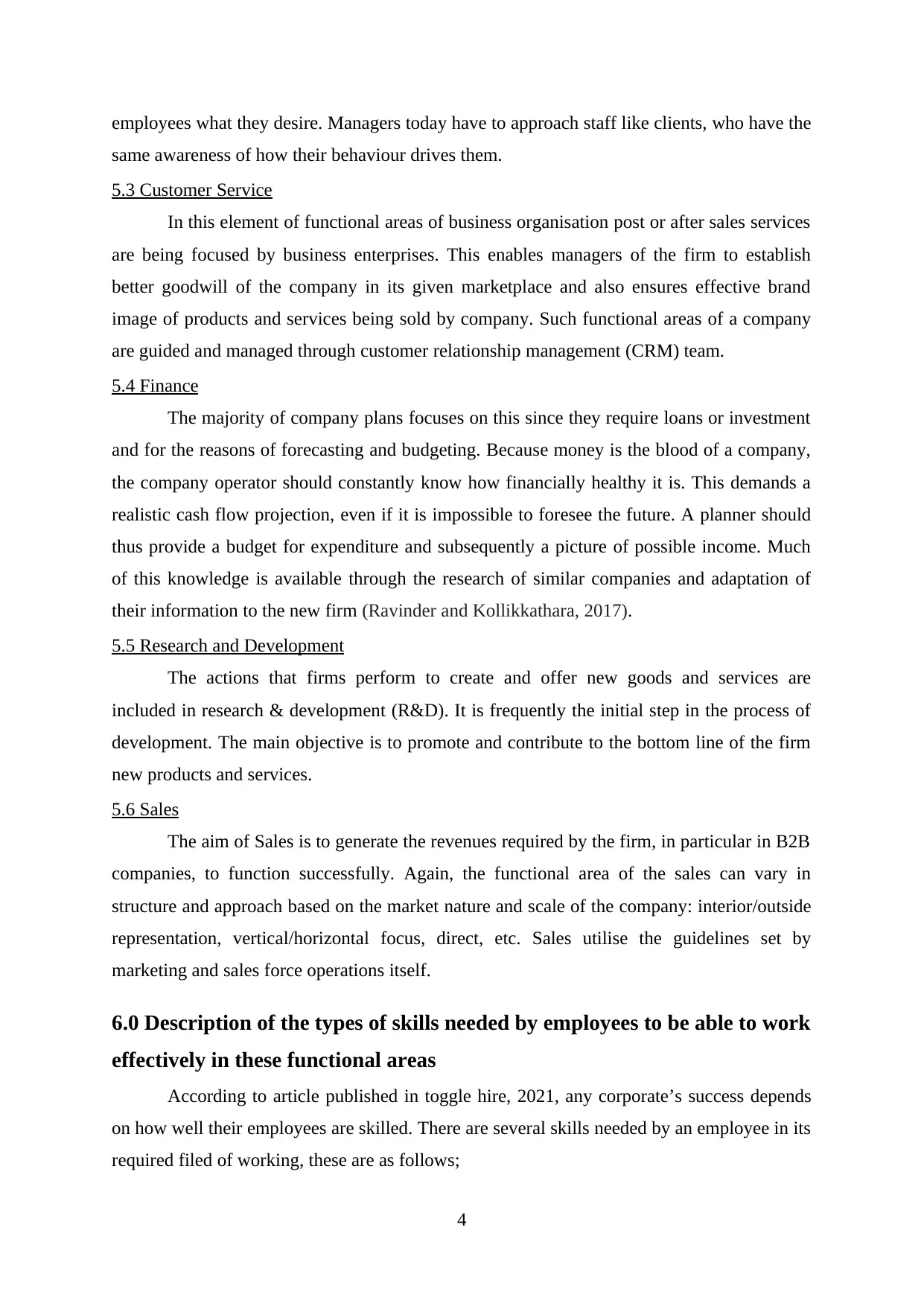
employees what they desire. Managers today have to approach staff like clients, who have the
same awareness of how their behaviour drives them.
5.3 Customer Service
In this element of functional areas of business organisation post or after sales services
are being focused by business enterprises. This enables managers of the firm to establish
better goodwill of the company in its given marketplace and also ensures effective brand
image of products and services being sold by company. Such functional areas of a company
are guided and managed through customer relationship management (CRM) team.
5.4 Finance
The majority of company plans focuses on this since they require loans or investment
and for the reasons of forecasting and budgeting. Because money is the blood of a company,
the company operator should constantly know how financially healthy it is. This demands a
realistic cash flow projection, even if it is impossible to foresee the future. A planner should
thus provide a budget for expenditure and subsequently a picture of possible income. Much
of this knowledge is available through the research of similar companies and adaptation of
their information to the new firm (Ravinder and Kollikkathara, 2017).
5.5 Research and Development
The actions that firms perform to create and offer new goods and services are
included in research & development (R&D). It is frequently the initial step in the process of
development. The main objective is to promote and contribute to the bottom line of the firm
new products and services.
5.6 Sales
The aim of Sales is to generate the revenues required by the firm, in particular in B2B
companies, to function successfully. Again, the functional area of the sales can vary in
structure and approach based on the market nature and scale of the company: interior/outside
representation, vertical/horizontal focus, direct, etc. Sales utilise the guidelines set by
marketing and sales force operations itself.
6.0 Description of the types of skills needed by employees to be able to work
effectively in these functional areas
According to article published in toggle hire, 2021, any corporate’s success depends
on how well their employees are skilled. There are several skills needed by an employee in its
required filed of working, these are as follows;
4
same awareness of how their behaviour drives them.
5.3 Customer Service
In this element of functional areas of business organisation post or after sales services
are being focused by business enterprises. This enables managers of the firm to establish
better goodwill of the company in its given marketplace and also ensures effective brand
image of products and services being sold by company. Such functional areas of a company
are guided and managed through customer relationship management (CRM) team.
5.4 Finance
The majority of company plans focuses on this since they require loans or investment
and for the reasons of forecasting and budgeting. Because money is the blood of a company,
the company operator should constantly know how financially healthy it is. This demands a
realistic cash flow projection, even if it is impossible to foresee the future. A planner should
thus provide a budget for expenditure and subsequently a picture of possible income. Much
of this knowledge is available through the research of similar companies and adaptation of
their information to the new firm (Ravinder and Kollikkathara, 2017).
5.5 Research and Development
The actions that firms perform to create and offer new goods and services are
included in research & development (R&D). It is frequently the initial step in the process of
development. The main objective is to promote and contribute to the bottom line of the firm
new products and services.
5.6 Sales
The aim of Sales is to generate the revenues required by the firm, in particular in B2B
companies, to function successfully. Again, the functional area of the sales can vary in
structure and approach based on the market nature and scale of the company: interior/outside
representation, vertical/horizontal focus, direct, etc. Sales utilise the guidelines set by
marketing and sales force operations itself.
6.0 Description of the types of skills needed by employees to be able to work
effectively in these functional areas
According to article published in toggle hire, 2021, any corporate’s success depends
on how well their employees are skilled. There are several skills needed by an employee in its
required filed of working, these are as follows;
4
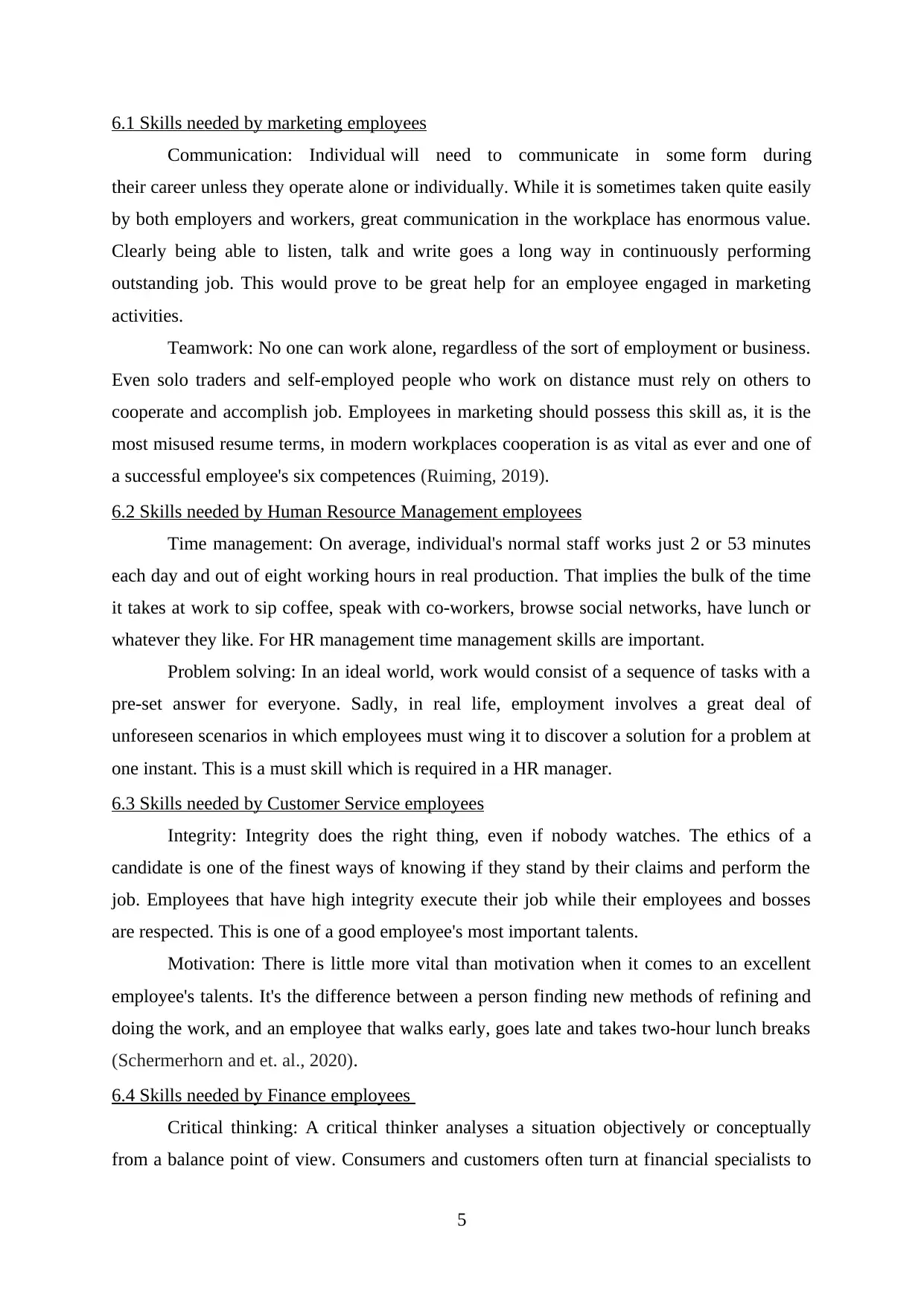
6.1 Skills needed by marketing employees
Communication: Individual will need to communicate in some form during
their career unless they operate alone or individually. While it is sometimes taken quite easily
by both employers and workers, great communication in the workplace has enormous value.
Clearly being able to listen, talk and write goes a long way in continuously performing
outstanding job. This would prove to be great help for an employee engaged in marketing
activities.
Teamwork: No one can work alone, regardless of the sort of employment or business.
Even solo traders and self-employed people who work on distance must rely on others to
cooperate and accomplish job. Employees in marketing should possess this skill as, it is the
most misused resume terms, in modern workplaces cooperation is as vital as ever and one of
a successful employee's six competences (Ruiming, 2019).
6.2 Skills needed by Human Resource Management employees
Time management: On average, individual's normal staff works just 2 or 53 minutes
each day and out of eight working hours in real production. That implies the bulk of the time
it takes at work to sip coffee, speak with co-workers, browse social networks, have lunch or
whatever they like. For HR management time management skills are important.
Problem solving: In an ideal world, work would consist of a sequence of tasks with a
pre-set answer for everyone. Sadly, in real life, employment involves a great deal of
unforeseen scenarios in which employees must wing it to discover a solution for a problem at
one instant. This is a must skill which is required in a HR manager.
6.3 Skills needed by Customer Service employees
Integrity: Integrity does the right thing, even if nobody watches. The ethics of a
candidate is one of the finest ways of knowing if they stand by their claims and perform the
job. Employees that have high integrity execute their job while their employees and bosses
are respected. This is one of a good employee's most important talents.
Motivation: There is little more vital than motivation when it comes to an excellent
employee's talents. It's the difference between a person finding new methods of refining and
doing the work, and an employee that walks early, goes late and takes two-hour lunch breaks
(Schermerhorn and et. al., 2020).
6.4 Skills needed by Finance employees
Critical thinking: A critical thinker analyses a situation objectively or conceptually
from a balance point of view. Consumers and customers often turn at financial specialists to
5
Communication: Individual will need to communicate in some form during
their career unless they operate alone or individually. While it is sometimes taken quite easily
by both employers and workers, great communication in the workplace has enormous value.
Clearly being able to listen, talk and write goes a long way in continuously performing
outstanding job. This would prove to be great help for an employee engaged in marketing
activities.
Teamwork: No one can work alone, regardless of the sort of employment or business.
Even solo traders and self-employed people who work on distance must rely on others to
cooperate and accomplish job. Employees in marketing should possess this skill as, it is the
most misused resume terms, in modern workplaces cooperation is as vital as ever and one of
a successful employee's six competences (Ruiming, 2019).
6.2 Skills needed by Human Resource Management employees
Time management: On average, individual's normal staff works just 2 or 53 minutes
each day and out of eight working hours in real production. That implies the bulk of the time
it takes at work to sip coffee, speak with co-workers, browse social networks, have lunch or
whatever they like. For HR management time management skills are important.
Problem solving: In an ideal world, work would consist of a sequence of tasks with a
pre-set answer for everyone. Sadly, in real life, employment involves a great deal of
unforeseen scenarios in which employees must wing it to discover a solution for a problem at
one instant. This is a must skill which is required in a HR manager.
6.3 Skills needed by Customer Service employees
Integrity: Integrity does the right thing, even if nobody watches. The ethics of a
candidate is one of the finest ways of knowing if they stand by their claims and perform the
job. Employees that have high integrity execute their job while their employees and bosses
are respected. This is one of a good employee's most important talents.
Motivation: There is little more vital than motivation when it comes to an excellent
employee's talents. It's the difference between a person finding new methods of refining and
doing the work, and an employee that walks early, goes late and takes two-hour lunch breaks
(Schermerhorn and et. al., 2020).
6.4 Skills needed by Finance employees
Critical thinking: A critical thinker analyses a situation objectively or conceptually
from a balance point of view. Consumers and customers often turn at financial specialists to
5
⊘ This is a preview!⊘
Do you want full access?
Subscribe today to unlock all pages.

Trusted by 1+ million students worldwide
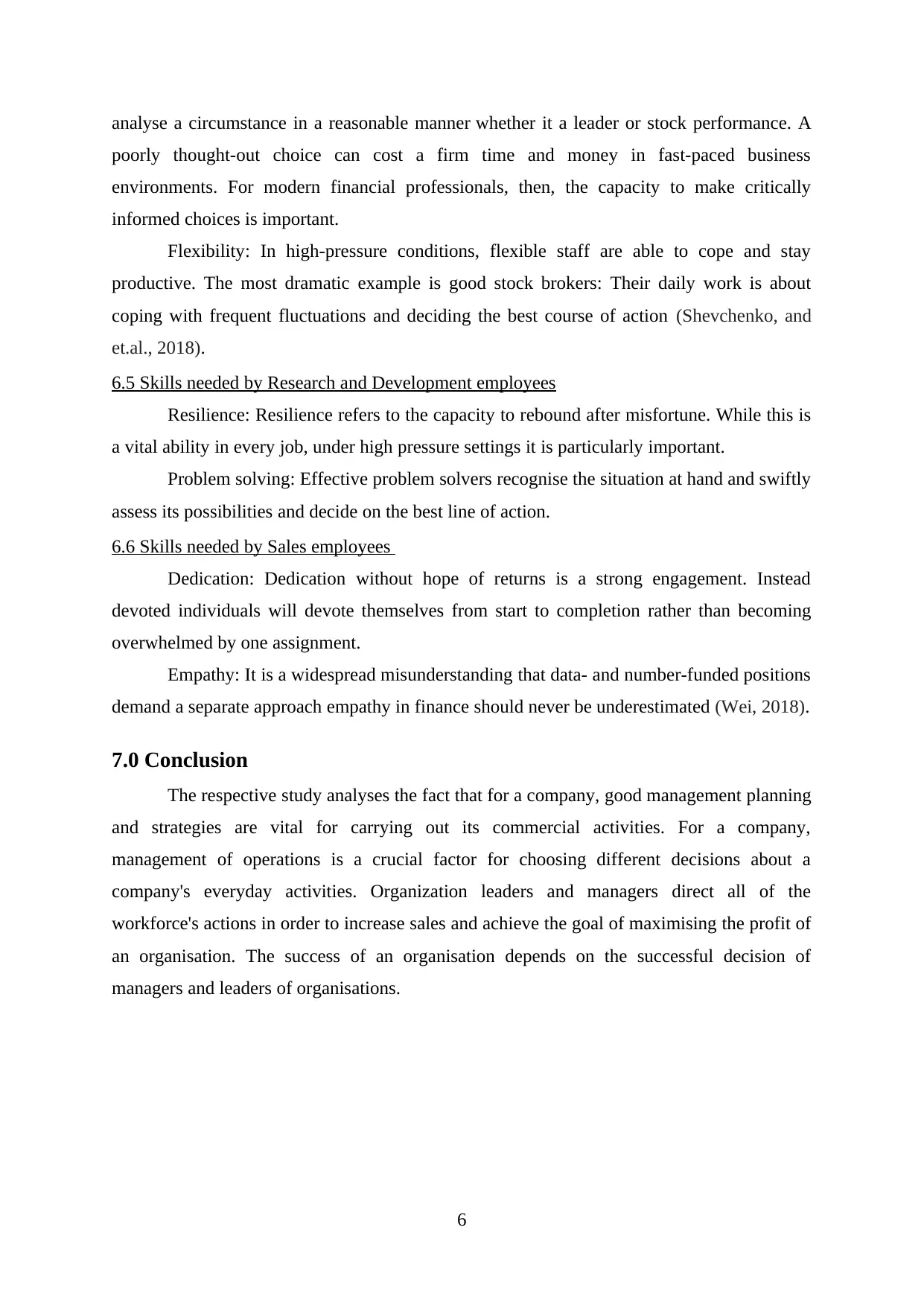
analyse a circumstance in a reasonable manner whether it a leader or stock performance. A
poorly thought-out choice can cost a firm time and money in fast-paced business
environments. For modern financial professionals, then, the capacity to make critically
informed choices is important.
Flexibility: In high-pressure conditions, flexible staff are able to cope and stay
productive. The most dramatic example is good stock brokers: Their daily work is about
coping with frequent fluctuations and deciding the best course of action (Shevchenko, and
et.al., 2018).
6.5 Skills needed by Research and Development employees
Resilience: Resilience refers to the capacity to rebound after misfortune. While this is
a vital ability in every job, under high pressure settings it is particularly important.
Problem solving: Effective problem solvers recognise the situation at hand and swiftly
assess its possibilities and decide on the best line of action.
6.6 Skills needed by Sales employees
Dedication: Dedication without hope of returns is a strong engagement. Instead
devoted individuals will devote themselves from start to completion rather than becoming
overwhelmed by one assignment.
Empathy: It is a widespread misunderstanding that data- and number-funded positions
demand a separate approach empathy in finance should never be underestimated (Wei, 2018).
7.0 Conclusion
The respective study analyses the fact that for a company, good management planning
and strategies are vital for carrying out its commercial activities. For a company,
management of operations is a crucial factor for choosing different decisions about a
company's everyday activities. Organization leaders and managers direct all of the
workforce's actions in order to increase sales and achieve the goal of maximising the profit of
an organisation. The success of an organisation depends on the successful decision of
managers and leaders of organisations.
6
poorly thought-out choice can cost a firm time and money in fast-paced business
environments. For modern financial professionals, then, the capacity to make critically
informed choices is important.
Flexibility: In high-pressure conditions, flexible staff are able to cope and stay
productive. The most dramatic example is good stock brokers: Their daily work is about
coping with frequent fluctuations and deciding the best course of action (Shevchenko, and
et.al., 2018).
6.5 Skills needed by Research and Development employees
Resilience: Resilience refers to the capacity to rebound after misfortune. While this is
a vital ability in every job, under high pressure settings it is particularly important.
Problem solving: Effective problem solvers recognise the situation at hand and swiftly
assess its possibilities and decide on the best line of action.
6.6 Skills needed by Sales employees
Dedication: Dedication without hope of returns is a strong engagement. Instead
devoted individuals will devote themselves from start to completion rather than becoming
overwhelmed by one assignment.
Empathy: It is a widespread misunderstanding that data- and number-funded positions
demand a separate approach empathy in finance should never be underestimated (Wei, 2018).
7.0 Conclusion
The respective study analyses the fact that for a company, good management planning
and strategies are vital for carrying out its commercial activities. For a company,
management of operations is a crucial factor for choosing different decisions about a
company's everyday activities. Organization leaders and managers direct all of the
workforce's actions in order to increase sales and achieve the goal of maximising the profit of
an organisation. The success of an organisation depends on the successful decision of
managers and leaders of organisations.
6
Paraphrase This Document
Need a fresh take? Get an instant paraphrase of this document with our AI Paraphraser
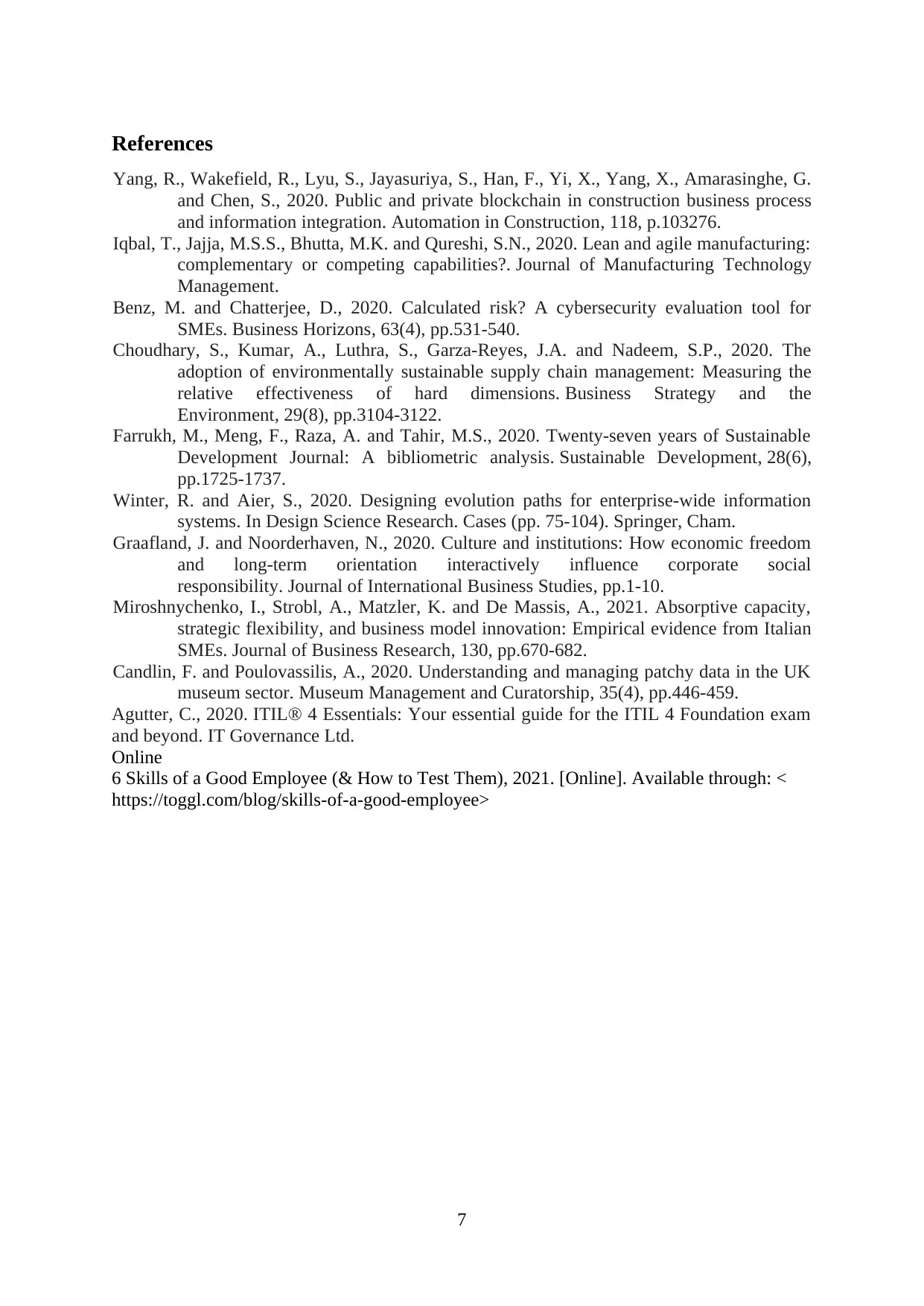
References
Yang, R., Wakefield, R., Lyu, S., Jayasuriya, S., Han, F., Yi, X., Yang, X., Amarasinghe, G.
and Chen, S., 2020. Public and private blockchain in construction business process
and information integration. Automation in Construction, 118, p.103276.
Iqbal, T., Jajja, M.S.S., Bhutta, M.K. and Qureshi, S.N., 2020. Lean and agile manufacturing:
complementary or competing capabilities?. Journal of Manufacturing Technology
Management.
Benz, M. and Chatterjee, D., 2020. Calculated risk? A cybersecurity evaluation tool for
SMEs. Business Horizons, 63(4), pp.531-540.
Choudhary, S., Kumar, A., Luthra, S., Garza‐Reyes, J.A. and Nadeem, S.P., 2020. The
adoption of environmentally sustainable supply chain management: Measuring the
relative effectiveness of hard dimensions. Business Strategy and the
Environment, 29(8), pp.3104-3122.
Farrukh, M., Meng, F., Raza, A. and Tahir, M.S., 2020. Twenty‐seven years of Sustainable
Development Journal: A bibliometric analysis. Sustainable Development, 28(6),
pp.1725-1737.
Winter, R. and Aier, S., 2020. Designing evolution paths for enterprise-wide information
systems. In Design Science Research. Cases (pp. 75-104). Springer, Cham.
Graafland, J. and Noorderhaven, N., 2020. Culture and institutions: How economic freedom
and long-term orientation interactively influence corporate social
responsibility. Journal of International Business Studies, pp.1-10.
Miroshnychenko, I., Strobl, A., Matzler, K. and De Massis, A., 2021. Absorptive capacity,
strategic flexibility, and business model innovation: Empirical evidence from Italian
SMEs. Journal of Business Research, 130, pp.670-682.
Candlin, F. and Poulovassilis, A., 2020. Understanding and managing patchy data in the UK
museum sector. Museum Management and Curatorship, 35(4), pp.446-459.
Agutter, C., 2020. ITIL® 4 Essentials: Your essential guide for the ITIL 4 Foundation exam
and beyond. IT Governance Ltd.
Online
6 Skills of a Good Employee (& How to Test Them), 2021. [Online]. Available through: <
https://toggl.com/blog/skills-of-a-good-employee>
7
Yang, R., Wakefield, R., Lyu, S., Jayasuriya, S., Han, F., Yi, X., Yang, X., Amarasinghe, G.
and Chen, S., 2020. Public and private blockchain in construction business process
and information integration. Automation in Construction, 118, p.103276.
Iqbal, T., Jajja, M.S.S., Bhutta, M.K. and Qureshi, S.N., 2020. Lean and agile manufacturing:
complementary or competing capabilities?. Journal of Manufacturing Technology
Management.
Benz, M. and Chatterjee, D., 2020. Calculated risk? A cybersecurity evaluation tool for
SMEs. Business Horizons, 63(4), pp.531-540.
Choudhary, S., Kumar, A., Luthra, S., Garza‐Reyes, J.A. and Nadeem, S.P., 2020. The
adoption of environmentally sustainable supply chain management: Measuring the
relative effectiveness of hard dimensions. Business Strategy and the
Environment, 29(8), pp.3104-3122.
Farrukh, M., Meng, F., Raza, A. and Tahir, M.S., 2020. Twenty‐seven years of Sustainable
Development Journal: A bibliometric analysis. Sustainable Development, 28(6),
pp.1725-1737.
Winter, R. and Aier, S., 2020. Designing evolution paths for enterprise-wide information
systems. In Design Science Research. Cases (pp. 75-104). Springer, Cham.
Graafland, J. and Noorderhaven, N., 2020. Culture and institutions: How economic freedom
and long-term orientation interactively influence corporate social
responsibility. Journal of International Business Studies, pp.1-10.
Miroshnychenko, I., Strobl, A., Matzler, K. and De Massis, A., 2021. Absorptive capacity,
strategic flexibility, and business model innovation: Empirical evidence from Italian
SMEs. Journal of Business Research, 130, pp.670-682.
Candlin, F. and Poulovassilis, A., 2020. Understanding and managing patchy data in the UK
museum sector. Museum Management and Curatorship, 35(4), pp.446-459.
Agutter, C., 2020. ITIL® 4 Essentials: Your essential guide for the ITIL 4 Foundation exam
and beyond. IT Governance Ltd.
Online
6 Skills of a Good Employee (& How to Test Them), 2021. [Online]. Available through: <
https://toggl.com/blog/skills-of-a-good-employee>
7

8
⊘ This is a preview!⊘
Do you want full access?
Subscribe today to unlock all pages.

Trusted by 1+ million students worldwide
1 out of 9
Related Documents
Your All-in-One AI-Powered Toolkit for Academic Success.
+13062052269
info@desklib.com
Available 24*7 on WhatsApp / Email
![[object Object]](/_next/static/media/star-bottom.7253800d.svg)
Unlock your academic potential
Copyright © 2020–2025 A2Z Services. All Rights Reserved. Developed and managed by ZUCOL.


